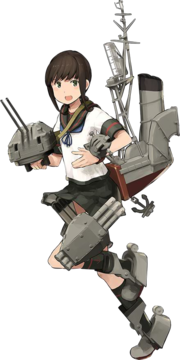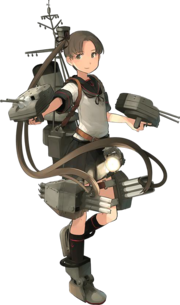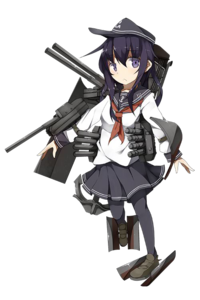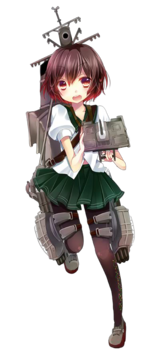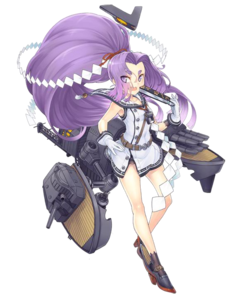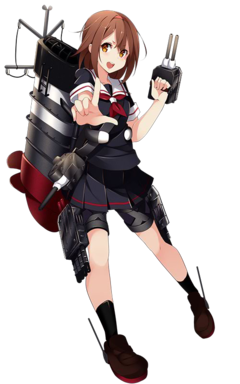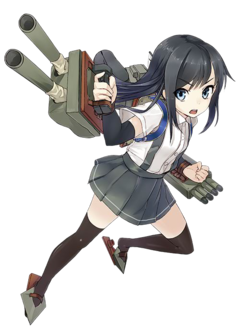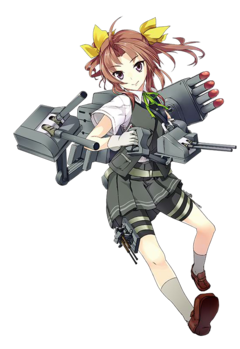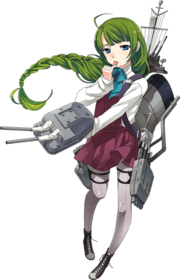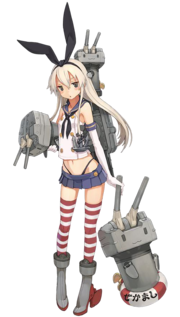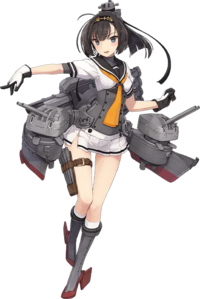- Welcome to the Kancolle Wiki!
- If you have any questions regarding site content, account registration, etc., please visit the KanColle Wiki Discord
Glossary
| Tutorial Portal |
|---|
| Setup and Registration (PC) · Kancolle Android Version · Connection · Troubleshooting · Basic Gameplay · FAQ · Glossary |
| Other Tutorials · Help pages |
Class classification
All of ship class codes on the list are based on USN Hull Classification Codes or modifications thereof.
| Terms | In-game Code | Japanese Name | English Name | |
|---|---|---|---|---|
| Kanji | Romaji | |||
| DD | 駆逐 | 駆逐艦 | Kuchikukan | Destroyer |
| AS | 潜母艦 | 潜水母艦 | Sensui bokan | Submarine Tender |
| SS | 潜 | 潜水艦 | Sensuikan | Submarine |
| SSV* | 潜母 | 潜水空母 | Sensuikūbo | Submarine Aircraft Carrier* |
| CL | 軽巡 | 軽巡洋艦 | Kei Jun'yōkan | Light Cruiser |
| CLT* | 雷巡 | 重雷装巡洋艦 | Jūraisō Jun'yōkan | Torpedo Cruiser* |
| CLp* | 練巡 | 練習巡洋艦 | Renshū Jun'yōkan | Training Cruiser* |
| CA | 重巡 | 重巡洋艦 | Jū Jun'yōkan | Heavy Cruiser |
| CAV* | 航巡 | 航空巡洋艦 | Kōkū Jun'yōkan | Aviation Cruiser* |
| AV | 水母 | 水上機母艦 | Suijōkibokan | Seaplane Tender |
| CVB/CV/CVL | - | 正規空母 | Sei'ki kūbo | Fleet Carrier |
| CVL | 軽母 | 軽空母 | Kei kūbo | Light Aircraft Carrier |
| CV | 航 | 航空母艦 | Kōkū bokan | Standard Aircraft Carrier |
| CV | 装母 | 装甲空母 | Sōkō kūbo | Armored Aircraft Carrier* |
| BB | 戦 | 戦艦 | Senkan | Battleship |
| FBB* | 戦 | 高速戦艦 | Kōsoku Senkan | Fast Battleship* |
| BBV* | 航戦 | 航空戦艦 | Kōkū Senkan | Aviation Battleship* |
| LHA* | 揚陸 | ドック型揚陸艦 | Dokkugata Yōrikukan | Amphibious Assault Ship* |
| AR | 工 | 工作艦 | Kōsakukan | Repair Ship |
Note:
- Terms "Kūbo" (空母) is a shorthand for "Kōkū bokan" (航空母艦), which means "Aircraft Carrier".
- In-game, the cards & encyclopedia have the ship class English Name, but some are rendered differently from above.
- "Aircraft Carrying Submarine" instead of "Submarine Aircraft Carrier"
- "Aircraft Cruiser" instead of "Aviation Cruiser"
- "Seaplane Carrier" instead of "Seaplane Tender"
- "Aircraft Carrier" instead of "Standard Aircraft Carrier"
- "Aircraft Carrier" instead of "Armored Aircraft Carrier"
- "Battleship" instead of "Fast Battleship"
- There are no USN hull classification codes for:
- Submarine Aircraft Carriers
- Training Cruisers
- Torpedo Cruisers
- Aviation Cruisers
- Armored Carriers
- KanColle-fans keep using CVB, which was for the largest aircraft carriers, such as Shinano.
- Fast Battleships
- Aviation Battleships
- Landing Craft Carriers (Amphibious Assault Ship)
General
API link
- For more information on this topic, see Play without VPN/Proxy.
Method to play the game without having to access the official DMM website.
Crossing the T
Classic naval strategy in which a line of warships cross in front of a line formation of enemy ships, allowing the crossing line to bring all their guns to bear while receiving fire from only the forward guns of the enemy. Gameplay wise, when your fleet crosses the enemy fleet, BOTH sides (counter-intuitively) gain a significant increase in damage dealt. When the opponent crosses your fleet, BOTH sides gain a significant damage decrease.
Docking
- For more information on this topic, see Docking.
Allow your damaged ships to be repaired to full health. The repair, also known as "bath" requires steel and fuel, and will take "some" time to complete. You can use the Instant repair item/Bucket (高速修復材) to instantly complete the repair.
Expedition
- For more information on this topic, see Expedition.
This is where you send your fleets to complete expeditions, in exchange for resources and certain items. For some ships and items, the only way to obtain them is by doing expedition. None of the expeditions involve combat, so you won't have to worry about losing any of your ships. You will, however, need to resupply their fuel tanks once the expedition is finished. Also, it is one of the main sources of income.
Food supply ship Mamiya
- For more information on this topic, see Morale/Fatigue.
Removes any fatigue on your fleet. If you don't use it, it could function as a fatigue indicator, as it informs you of when a girl in your fleet has fatigue, even without the orange fatigue indication. See here for the Wikipedia entry.
Modernization
- For more information on this topic, see Modernization.
Process of using unused ships to increase stats (Firepower, AA, Torpedo, Armor) of a single ship. Also known as Merging.
- For more information on this topic, see Exercises (PvP).
PVP-like battle with no risk of repair and sinking, and only costs the player fuel, ammo and bauxite. Opponent teams update in real-time, but there is no simultaneous play.
- New opponent list refreshed at 03:00 and 15:00 JST
Phases of Battle
- For more information on this topic, see Combat.
- Day Battle
- Reconnaissance (Stat boost, avoid being T-crossed)
- Initial airstrike (opening bombing, air superiority)
- Support fleet attack
- Opening/initial torpedo strike (see Type A Ko-hyoteki (甲標的甲型))
- Shelling/artillery phase (regular airstrike happens here)
- Torpedo salvo
- Night Battle
Remodel
- For more information on this topic, see Remodel.
Often confused with Modernization, will usually result in *ship name*-Kai (改). also known as Upgrading.
Fatigue
- For more information on this topic, see Alright, I built my ship, kicked some ass and I noticed the orange faces. What gives?.
Orange/sad faces are displayed next to the ship icon if they are too fatigued. Rest them for 15 minutes or so if it happens. Fatigue will reduce by 3 every 3 minutes.
Fatigued ships will have lower accuracy and evasion.
If your ships are still fatigued upon returning from expedition, your expedition will end up failing even with all other criteria fulfilled.
Sparkle
- For more information on this topic, see My ship is sparkling/glittering!.
The polar opposite of Fatigue. If one or more of your ships sparkle, they will gain evasion boost during sortie. The evasion boost stats are not shown in your ship stats directly. Or, if you choose to send a sparkling ship on an expedition, it will have a chance for 150% resource gain and a higher likelihood of returning with a special item (note that this requires the entire fleet to be consisting of sparkling ships).
Medal
- For more information on this topic, see How to exchange medals for rewards?.
Medal(勲章), is a multi-purpose item that can be used to exchange for a small amount of resources or a remodel blueprint(改装設計図).
- 1 medal can be used to exchange for
 x300,
x300,  x300,
x300,  x300,
x300,  x300 and
x300 and  x2.
x2. - 1 medal can also be used to exchange for Improvement Materials
 x4.
x4.
- 4 medals are needed to exchange for 1 x remodel blueprint.
Medals can be obtained by clearing certain maps. You can find the amount of medals owned by accessing the Item page(アイテム) at the top menu bar of the main screen. Remodel blueprint is needed to remodel certain ships.
Tracer-fire effect
This occurs when a ship fires any equipped machine guns to defend itself, reducing incoming damage from enemy bombers. Your flagship will always do this by default, even without any anti-air stat.
Equipment
Color-coded Aircraft
 Red Plane: Carrier-based Dive Bomber
Red Plane: Carrier-based Dive Bomber Blue Plane: Carrier-based Torpedo Bomber
Blue Plane: Carrier-based Torpedo Bomber Green Plane: Carrier-based Fighter
Green Plane: Carrier-based Fighter Yellow Plane: Carrier-based Recon Aircraft
Yellow Plane: Carrier-based Recon Aircraft
 Light Green Plane: Seaplane Bomber and Reconnaissance Seaplane
Light Green Plane: Seaplane Bomber and Reconnaissance Seaplane
It is based on their roles, not ability.
 Red Gun: Main Gun; Primarily used against ships, with a secondary role as AA.
Red Gun: Main Gun; Primarily used against ships, with a secondary role as AA. Yellow Gun: Secondary Gun; increase in accuracy and AA stats.
Yellow Gun: Secondary Gun; increase in accuracy and AA stats.- Green Gun: High-angle dual-purpose guns or AA machine guns
Midget Submarine
Also known by it's design code name Type A Ko-hyoteki (![]() 甲標的甲型) which literally means Target Type A, it's a submarine equipable on Torpedo Cruisers, Submarines, and Seaplane Tenders. Frequently used because of their ability to attack before the shelling phase.
甲標的甲型) which literally means Target Type A, it's a submarine equipable on Torpedo Cruisers, Submarines, and Seaplane Tenders. Frequently used because of their ability to attack before the shelling phase.
Turbine
Turbine![]() are equippable on any ship. Turbine increases the evasion stat causing enemies have higher miss rate.
are equippable on any ship. Turbine increases the evasion stat causing enemies have higher miss rate.
Trivia
!すでのな
One of Inazuma's lines written "backwards", in traditional Japanese format. Also appears as a wall scroll in the furniture page.
2-4-11
The fleet idol, Naka-chan dayo!~ (see number 48 designation).
2-4-11 refers to the fuel/ammo/steel combination received from her scrap.
Beaver
See Yukikaze and notice the similarities. pic related. Japanese fans call her 'Hamster' instead.
Big Seven
A group of warship built to carry the biggest naval gun (41cm) allowed by the Washington Naval Treaty. It comprise of Nagato, Mutsu, USS West Virginia, USS Maryland, USS Colorado, HMS Rodney, and HMS Nelson.
Black Rick Shooter/Black Ruck Shooter
Nickname of Standard Carrier Wo-Class Kai Flagship
- Abbreviated BRS
Black Wock Shooter
Nickname of Standard Carrier Wo-Class Kai Flagship
- Abbreviated BWS
BURNING LOVE
Notable line from Kongou, a Kongou-class battleship built by Vickers Shipbuilding Company. Loves tea and fond of using English words due to her being built in England. Other examples:
- 提督ゥ~、You've Got Mail! Love letterは許さないからネ!
- Wow! Congratulations!
- Tea timeは大事にしないとネー
KTKM
Shorthand for Kitakami. Wordplay from Japanese netslang KTKR which is read as kita kore, literally 'it's here', sort of like 'woohoo I got it' or 'I've been waiting for this!'.
Melon-chan
Nickname for Yuubari due to her uniform color scheme and general resemblance to a melon as well as the City of Yuubari, on the namesake Yuubari River, which is well known for its melons.
Nagamon
The name is due to Nagato's (長門) second kanji, 門, which can be pronounced as mon.
Instead of being cool and serious, Nagato is usually depicted doing silly things or showing love to random destroyers, Northern Hime, and other girls.
Rensouhou-chan (連装砲ちゃん)
A Danbo-like robot which appears with Shimakaze. Amatsukaze, having a more formal character, calls hers Rensouhou-kun instead.
RJ/Airport
Light Carrier Ryūjō which has a second flight deck very flat chest. Don't complain about it, the chart agrees.
Tenryuu Kindergarten
A common theme where Tenryuu and her destroyers escort was regularly used in expeditions due to her low fuel and ammo cost. The official 4-koma also shows Tenryuu as being good at taking care of children (destroyers), hence the name.
Zekamashi (ぜかまし)
Shimakaze's name read backward (in traditional Japanese, characters are read right-to-left). Found on one of the Rensouhou-chan's life buoys.
Birthdays of Ship Girls
The birthdays of the ship girls are based from their date of launch sourced from their appropriate wikipedia pages. Alternative calculation method, like the date they get named or the date their construction start, could/would also be applied in some occasion.
Destroyers
| Fubuki Class Destroyers
Also called Special Type Destroyers. Fubiki class broke down into three groups as Type I, Type II (Ayanami Class), and Akatsuki Class. Although, Fubuki Class was considered as the most powerful destroyers in the world during the time of WWII. They got a serious stability problem due to restriction by Washington Naval Treaty
|
- 1st Fubuki 15 November 1927
- 2nd Shirayuki 20 March 1928
- 3rd Hatsuyuki 29 September 1928
- 4th Miyuki 26 June 1928
- 5th Murakumo 27 September 1928
- 9th Isonami 24 November 1927
Ayanami Class Destroyers
|
| Akatsuki Class Destroyers
The last four Special Type destroyers that got enough differences to deserve a new class name. By the way, they still had same stability problems as Fubuki Class
|
| Mutsuki Class Destroyers
The first destroyers class built under Washington Naval Treaty, with introduce of several new features, especially heavy torpedo armament. |
| Hatsuharu Class Destroyers
Hatsuharu Class faced by London Naval Treaty, that put more restriction than Washington Naval Treaty. Yet, this class confronted further stability problems and needed extensive modification and redesign.
|
- 2nd Hatsuharu 27 February 1933
- 3rd Hatsushimo 4 November 1933
- 4th Nenohi 22 December 1932
- 5th Wakaba 18 March 1934
| Shiratsuyu Class Destroyers
Shiratsuyu Class was redesigned from unstable Hatsuharu Class, by means of breaking London Naval Treaty.
|
| Asashio Class Destroyers
Another class to ignore London Naval Treaty. Asashio Class designed with improved boilers resulted in faster speed than preceding Shiratsuyu Class (1 knot faster). None destroyers from this class survived the war. |
| Kagerou Class Destroyers
Kagerou Class design, based on the success of previous Asashio Class, resulted in slightly improve stability.
|
- 1st Akigumo 11 April 1941
- 2nd Amatsukaze 19 October 1939
- 5th Hamakaze 25 November 1940
- 6th Hatsukaze 24 January 1939
- 8th Isokaze 19 June 1939
- 9th Kagerou 27 September 1938
- 10th Kuroshio 25 October 1938
- 11th Maikaze 15 March 1941
- 13th Nowaki 17 September 1940
- 15th Shiranui 28 June 1938
- 16th Tanikaze 1 November 1940
- 17th Tokitsukaze 10 November 1939
- 18th Urakaze 19 April 1940
- 19th Yukikaze 24 March 1939
| Yuugumo Class Destroyers
Yuugumo Class was the Kagerou Class with some minor improvements. They assigned to escort primary fleet units most of time. |
| Shimakaze Class Destroyers
Design based on Yuugumo Class, with the purpose to achieved as high speed as possible to gain a tactical advantage in naval combat. By the way, its performance wasn't that good compared to very complex design. So, the construction of this class was cancelled, resulted Shimakaze being the only ship in the class |
- 1st (and only) Shimakaze 18 July 1942
| Akizuki Class Destroyers
Akizuki Class built on purpose of antiaircraft warfare. Also, the class that IJN considered as their most successful destroyers. |
- 1st Akizuki 2 July 1941
Light Cruisers
- Tenryuu 11 March
- Tatsuta 29 May
- Kuma 14 July
- Tama 10 February
- Kiso 14 December
- Nagara 25 April
- Isuzu 29 October
- Natori February 16
- Yura 15 February
- Kinu 29 May
- Abukuma 16 March
- Sendai 30 October
- Jintsuu 8 December
- Naka 24 March
- Ooi 15 July
- Kitakami 3 July
- Yuubari 5 March
- Agano 22 October
- Noshiro 19 July
- Yahagi 25 October
- Sakawa 9 April
- Ooyodo 2 April
Heavy Cruisers
- Furutaka 25 February
- Kako 10 April
- Aoba 25 September
- Kinugasa 24 October
- Myoukou 16 April
- Nachi 15 June
- Ashigara 22 April
- Haguro 24 March
- Takao 12 May
- Atago 16 June
- Maya 8 November
- Choukai 30 June
- Tone 21 November
- Chikuma 19 March
- Mogami 14 March
- Mikuma 31 May
- Suzuya 20 November
- Kumano 15 October
- Prinz Eugen 22 August
Battleships
- Nagato 9 November
- Mutsu 31 May
- Kongou 18 May
- Hiei 21 November
- Kirishima 1 December
- Haruna 14 December
- Fusou 28 March
- Yamashiro 3 November
- Ise 12 November
- Hyuuga 27 January
- Yamato 8 August
- Musashi 1 November
- Bismarck 14 February
Light Carriers
- Houshou 13 November
- Ryuujou 2 April
- Hiyou 24 June
- Junyou 26 June
- Shohou 1 June
- Zuihou 19 June
- Chitose 29 November
- Chiyoda 29 November
- Ryuuhou 16 November
Standard Carriers
- Akagi 22 April
- Kaga 17 November
- Souryuu 21 December
- Hiryuu 16 November
- Shoukaku 1 June
- Zuikaku 27 November
- Taihou 7 March
- Unryuu 25 September
- Amagi 1 October
Submarines
- I-8 20 July
- I-19 16 September
- I-168 26 June
- 1-58 30 June
- I-401 8 January
- Maruyu 31 October
- U-511 21 Febuary
- RO-500 16 September
Auxiliary
- Akitsumaru 24 Sept
- Akashi 29 June
- Taigei/Ryuuhou 16 November
- Mamiya 26 October
- Katori 14 December
List of vessels by Japanese voice actresses
List of vessels by artist
List of music by composers
| Composer | Tracks |
|---|---|
| Okamiya Michio (岡宮道生) | Game, Event, OST -Akatsuki-, Incomplete |
| Ookoshi Kaori ( 大越香里) | Game, Event, OST -Akatsuki-, Incomplete |
| Usami Hiroshi (宇佐美宏) | Game, Event, OST -Akatsuki-, Incomplete |
| Uncredited | Japanese wiki |
Acronyms
Ever see an acronym in the wiki you didn't know the meaning of and urbandictionary doesn't have it? While it is preferable to not use acronyms to avoid confusion, some discussions will inevitably have them. This is an incomplete list of acronyms used in discussions by English-speaking KanColle players.
- AA - Anti-Air
- ACH - Aircraft Carrier Hime
- ASW - Anti-Submarine Warfare
- AS - Air Superiority
- AS+ - Air Supremacy
- BP - Blueprint
- CI - Cut-In
- CV - Character Voice, same as VA
- DA - Double Attack
- EO - Extra Operation (maps 1-5, 2-5, 3-5, 5-5, and some event maps)
- FBB - Fast Battleship
- FCF - Fleet Command Facility
- FP - Firepower
- AFP - Air Fighter Power
- FS - Flagship
- KC - Kantai Collection
- LSC - Large Ship Construction
- LoS/LOS - Line of Sight
- RSC - Resources
- RNG - Random Number Generator
- SCAMP - Skilled Carrier-based Aircraft Maintenance Personnel
- TP -Torpedo
- VA - Voice Actress, same as CV
- AACI - Anti-Air Cut-in
- GS - Great Success
